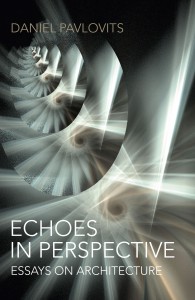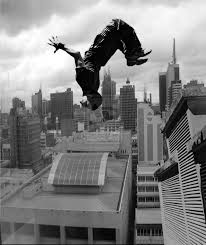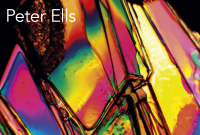
In recent decades a new form of urban exercise and competitive sport has emerged, which bases itself upon the
practitioner moving and finding their way through a built environment in a creative self-styled manner, often at speed. The movement is called Parkour, which takes its name from the French term
parcours meaning course.
During the practice of Parkour, the practitioner moves through what for them is considered an obstacle course of a built environment such as a housing estate or other urban environment in such a way as to displace normal paths, cues and trajectories of movement. In the practice of Parkour, the normal, architecturally and culturally conceived and designed patterns of movement through a built environment become superseded by other, perhaps more efficient, but nonetheless more creative methods of movement and spatial reading. Parkour indeed has thus been termed alternatively as l’art du deplacement, meaning the art of displacement, whereby the person practicing it, “adopts other ways than those set-out architecturally or culturally”1 for moving through an environment, and as such displaces the habitual cues of movement through a space.
The emergence of such a sport tells us two things most immediately about architecture: the first, that culturally recognized architectural elements of form such as stairs, doors, railings, parapets, ledges and walkways are forms of repetition that control and prescribe methods of movement, and which people use in a thus pre-determined culturally recognized way; secondly, that other ways of moving through built form is possible, one that results in an art of displacement of the prescribed and dictated mode of use and movement associated with cultural forms and prescribed by them.
From such recognition it follows that architecturally and culturally recognized forms begetting movement through a space might be considered in some cases to delimit modes of movement, the use and experience of a space. Thus we might say that the culturally and architecturally recognized forms of repetition normally used in the built environment are elements of form that Deleuze and Guattari might term as striated elements of form, elements that harness a pre-determined and pre-attached, delimited and delimiting mode of use. Such forms enable and dictate movement in a pre-prescribed manner in their method of use, whereby a door, a parapet, a walkway, a balcony has a certain function attached to it, which function in turn predetermines and delimits its habitual use.
The art of Parkour, however, turns the perception of function of habitual use of such built forms into another reading, one in which their function produces an entirely different pattern of behavior and movement in relation to their form. Parkour thus destabilizes the function of such pre-determining elements of form, which if we take them to be striated elements of form predetermining behavior and use, achieves a “deterritorialising” of them, borrowing again a Deleuze/Guattarian term, toward smooth space as an anti-thesis to the pre-determined habitual and thus striated pattern of function they culturally inhabit.
Thus architecture and culturally recognized elements of form within architecture can be put to use in two opposing yet interconnected ways: one as a culturally recognized norm of form and related function preceding from it, which produces a delimitation of use and behavior in relation to it, the other as a recognition of possibility for otherness and other movement, use and behavior in relation to such form, producing different modes of movement, use and behavior than culturally might be recognized in relation to it. In doing so, Parkour enables a deterritorialising of the striated coupling of form and function toward the smooth inhabitation and movement across a built environment.
Daniel Pavlovits is a writer, educator and editor. He has taught in schools of architecture at the University of New South Wales, University of Technology Sydney, University College for the Creative Arts Canterbury UK and University of East London. He has given lectures, contributed to symposia and held seminars on issues architectural in France, The Netherlands, the United Kingdom and Australia. His writing has been published in Architecture Review (UK), Architecture Review (Australia), Archis, Newsline and The Architects Newspaper.
 Echoes in Perspective_essays on architecture by Daniel
Pavlovits
Echoes in Perspective_essays on architecture by Daniel
Pavlovits
One could read the collection of essays herein as a political voice to architecture and the architecture profession, constantly gnawing away at the disciplinary, only to find favor in the imaginative, intellectually interesting and the creative. Beyond embodying a collection of thought on architecture and its discipline, the present collection of essays also serves as a not-so-veiled political program for the possibility of architecture.
BUY ONLINE
Categories:
0 comments on this article








